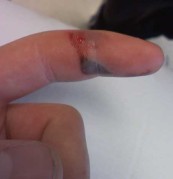Keeping kids safe and social services off your back
A ruptured patella tendon. A dislocated shoulder. A broken hand. A broken arm. A bone bruise. Another bone bruise. Torn calf muscle. Strained ulnar nerve. Various bumps, bruises, welts, cuts and scrapes. Those are just some of the ways we’ve managed to hurt ourselves playing sports. At one point, the admitting attendant at the Urgent Care knew my name and that is not a good thing. Especially when they start asking your kids those questions.
If your kids play sports, it’s inevitable that you’ll suffer an injury or two. That’s why we carry the cold packs, Advil and extra large band aids. And why I wish I had bought an x-ray machine about 10 years ago. But, there are some ways you can reduce or prevent injuries and keep Child Welfare at bay. Read on, and learn how to keep your kids safer and injury-free.
Get the right stuff
There are some basic things that every parent can take care of, like making sure that any needed equipment fits. Kids grow quickly and the pads that fit last week may be too short this week. You also want to make sure equipment is in good condition. Somehow, my kids always managed to crack their shin pads, which the guy at the sporting goods store said he had never seen happen before, and we were forever replacing them.
Another basic is to make sure your athlete is wearing the equipment properly. An unbuckled chin strap isn’t going to keep a helmet on, pants that are sagged below the butt (yes, I’m talking to you, midget hockey players!) don’t protect kidneys. You should also watch out for overuse injuries, really common in baseball pitchers, for example, who use the same throwing motion over and over. Keep track of your player’s pitch count and encourage them to take a some time off from playing. Another reason why kids should play more than one sport.
Tips from the pros
Then there’s the advice from the pros. One of my favorite web sports docs is Dr. David Geier (@DrDavidGeier on Twitter) from the Medical University of South Carolina. He’s got great blog posts, including this one on preventing ACL injuries, especially in female athletes. Here’s a sample:
First, I would recommend that parents of female athletes spend time finding a sports medicine program that teaches an ACL injury prevention program, specifically one that is tailored to that sport. Girls tend to land and turn with their knees fully extended (unlike boys), which put the ACL at risk. Fortunately exercise programs can teach girls to jump and turn with their knees bent. Ten minutes is spent daily performing the exercise program. These exercises, once learned, should be done every day before practices and games. They replace the traditional warm-up exercises players do. In fact, if someone watches athletes doing them and doesn’t know, it looks like they are doing a normal warm-up. But done every day, these programs have been shown to at least decrease the chance of ACL tears occurring.
Soccer tips
And Tony Meola and Allstate sent me some youth soccer tips. I like how he talks about equipment, but also technique. There’s a right way and a wrong way to do things, and the wrong way is what gets players injured. Learning the technique can make you a better player and keep you healthy.
- Avoid injuries by wearing shoes that fit. Not much equipment is required for soccer, but cleats that are too small or too big can irritate your feet. Also, don’t worry about those flashy cleats your friend is wearing. Wear what works for you. Still learning the game? Go with molded cleats over the more dangerous metal spikes. Go with a more all purpose cleat until you get a better feel for soccer cleats.
- For all goalkeepers out there, learn how to dive properly. The better your technique, the less inclined your are to get injured. Also, wear the padded pants to protect your legs. Taking proper training to be a goalkeeper will be well worth it.
- Cross-training by participating in multiple sports is a great way to train as well as avoid injuries, especially for field players. For example, the constant cutting, different speeds and short bursts in basketball translate very well to soccer. Being involved in other sports also helps.
- Don’t be a hero. Some soccer injuries can be caused by consistent overuse or playing through pain. If you sustain an injury, take the time to heal up so you can get back on the field! And remember – injuries need to be managed long term, not just in the short term.
- Whether you win or lose, join your team for a brief cool down jog after the game. Icing after games is also a great way to begin the recovery process. A dip in the pool is never a bad idea either.



